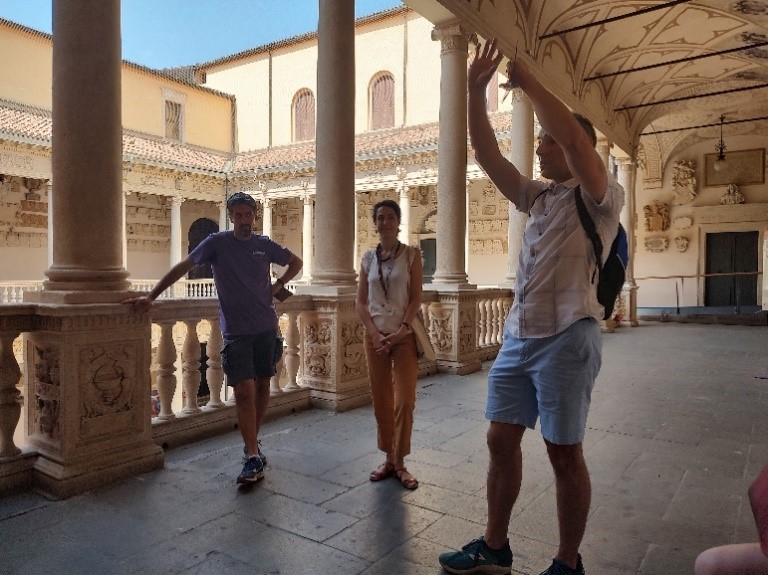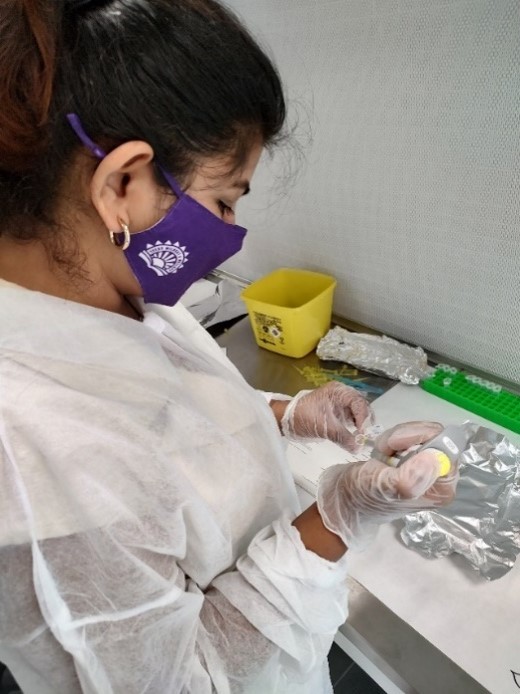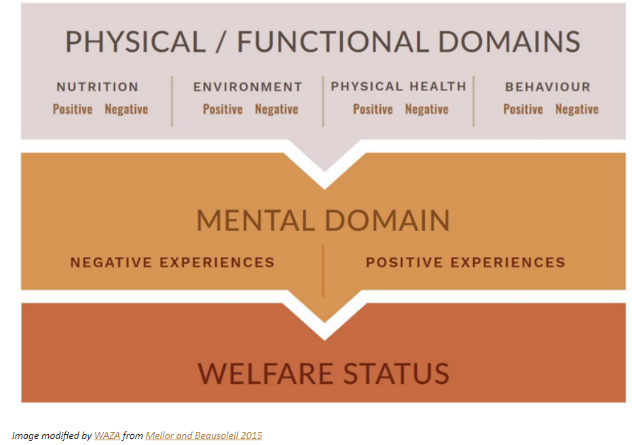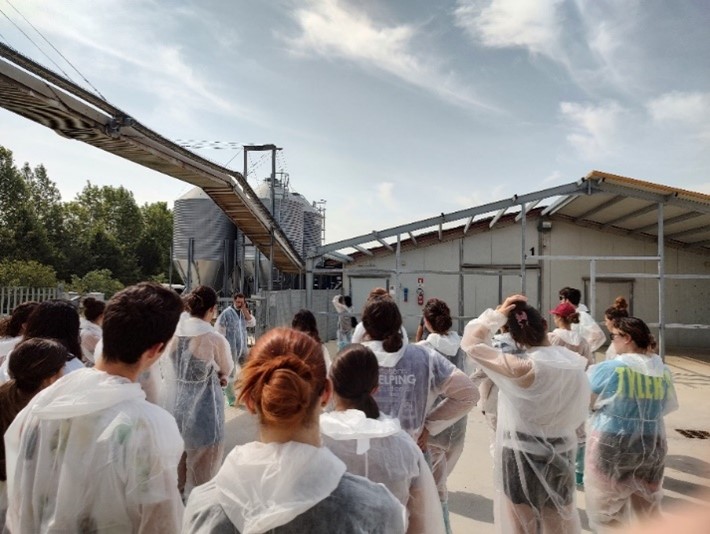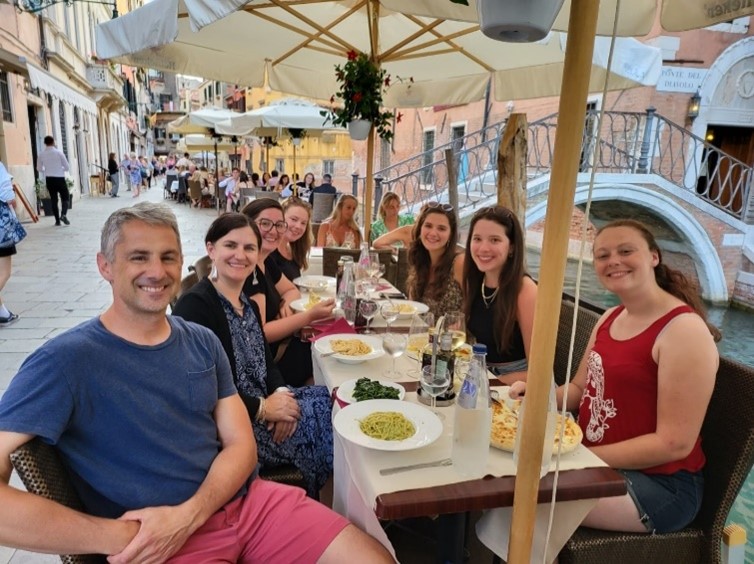One Health Newsletter
iMOVES Summer 2022 Course: Food Safety, Public Health, and Animal Welfare in Terrestrial and Aquatic Animals
Author
Lauren Davis
In June 2022, two faculty members and six students from the Kansas State University’s College of Veterinary Medicine participated in the 2022 cohort of the International Mobility of Veterinary Students (iMOVES) program, hosted by the University of Padova in Italy. This specialized and intensive summer course focuses on a variety of topics that fall under the One Health umbrella including food safety, aquatic and terrestrial animal welfare, and public health. The 2022 summer program marked the first year returning to in-person attendance after a two-year hiatus due to the COVID-19 pandemic. In 2020, the course was cancelled and in 2021, the course was 100% online via Zoom with use of online tools to encourage student participation.
The 2022 course, spearheaded by Professors Marco Patruno and Rudi Cassini from the University of Padova, followed in the footsteps of the past year. This hybrid course continued to use videoconferencing tools, which allowed participation of guest lecturers from around the globe. From June 6-10, students listened to presentations by experts from Australia, Czech Republic, Italy, Republic of South Africa, and the United States.
When the in-person courses convened during the week of June 20, many additional experts from the University of Padova and Austria led thought-provoking lectures that included real-world examples and connections to veterinary medicine and One Health. From foodborne pathogens to aquatic sustainability to zoo animal enrichment, iMOVES continued to show the interdisciplinary thought processes and tools that are required to be successful. This cross-cultural experience was eye-opening for many students, contributing greatly to their intellectual pursuits and future career paths. By design, the course allowed students and faculty members to engage in thoughtful discussions and cross geographic boundaries.
Figure 1: Professor Justin Kastner (Kansas State University) providing insight into the history of the Palazzo Bo (Photo credit: Lauren Davis)
Food Safety, Food Fraud, and Biosecurity
Food safety and biosecurity are included in discussions on Seafood Related Illnesses, Control of Transmissible Diseases in Zoo, The Illustrative Challenges of the Seafood Trade, Food-Borne Pathogens Overviews, and Pathogenic Effects of Cetacean Parasites. Practical field visits to a seafood processing company (FIORITAL) and a poultry farm in Venice allowed students to learn about the impact of zoonotic diseases (such as Avian Influenza). As Avian Influenza affected numerous countries, including Italy, protocols were adjusted to stop the spread and avoid biosecurity failings and missteps. For example, we were not allowed to visit a farm that currently had live animals. The government also enacted regulations about distancing between new and current farms as the virus is airborne.
Food protection and food fraud were also discussed during one laboratory session, where the students were asked to perform polymerase chain reaction (PCR) testing on cheese to determine food fraud of buffalo mozzarella. This one lab crosses the disciplines of chemistry, public health, and food safety.
At FIORITAL, we observed the process from beginning of the receival of live crustaceans through to preparation, packaging, and testing in the laboratory for foodborne pathogens and toxins. It is imperative to complete routine and thorough testing to ensure food safety for the consumer.
Figure 2. Master of Public Health Student, Snehal Gawhale, participating in a laboratory class (Photo Credit: Lauren Davis)
Animal Welfare
“Animal Welfare requires the commitment to the…entire community, not just a single species.” -Theresa Quintana
The wealth of knowledge regarding global animal welfare, conservation, and sustainability includes many different perspectives such as in the ongoing pursuit to improve the animals’ quality of life around the world, many decisions that are made with the goal of improving animal welfare have come to have quite opposite and even detrimental effects.
One of the most thought-provoking presentations on this topic came from Dr. Greg Vogt, CEO of Conservation Guardians - South Africa, who discussed animal welfare challenges from a South African perspective. He described the overpopulation of elephants in Kruger National Park, due to the moratorium on culling put in place in the mid 1990’s. According to Theresa Quintana, a graduate student in public health who attended the 2022 course, “as a result of the overabundance of elephants, other animals have suffered within the boundaries of the park due to environmental destruction and diminished resources. To control the population, the park began closing bore holes (man-made water sources) limiting water. While this was effective at reducing the elephant population growth, the management of the closures was haphazard at best, with no regard for the welfare of any of the animals in the park.”
Animal welfare is a multifaceted theme and requires both broad and fine thinking. For this reason, it can also be directly and indirectly tied to animal health, the quality of the final products such as meat and eggs, and the overall food safety. We must consider how humans have influenced the lives of the animals, including current trends, new scientific findings, new laws and regulations, and production practices.
What are the best practices and challenges? A good rule for identifying best practices start with evaluating the animals based on the Five Freedoms of Animal Welfare and the Five Domains frameworks. As shared in Dr. Vogt’s example, if we evaluate other animals in the park after the culling ban based on the Five Domains diagram (Figure 3), which was modified by the World Association of Zoos and Aquariums, we can see that many animals have negative experiences regarding Nutrition, Environment, Physical Health, and Behavior which also negatively impacts their mental state leading to a negative welfare status. This includes the elephants themselves, as the man-made water holes were closed. So, rather than a quick and humane death, many animals struggled with no or limited to access to water (nutrition), which affected all of the other domains and their mental state ultimately leading to negative and potentially fatal outcomes.
Figure 3. The Five Domains Diagram (Source: Zoo and Aquarium Association Australasia, 2022; https://zooaquarium.org.au/public/Public/Animal-Welfare/The-Five-Domains.aspx).
800-Years of Education and One Health Initiatives
Notably, 2022 marks the 800th birthday for the University of Padova (Padua) in Italy. This milestone, celebrating near a millennium of learning, showcases how the concept of One Health is not a new one. Connecting with students and teachers from around the world, all with the same common goals of seeking knowledge and participating in One Health initiatives, was one of the most noteworthy and important elements of this course.
“The iMOVES course is a multidisciplinary course that examines food safety, veterinary medicine, and public health practices and policy. It exemplifies how cross-sector collaboration is needed to address, study, and monitor threats to public health,” says Emma Uridge, a graduate student in public health at Kansas State University.
The importance of multidisciplinary learning and collaboration is a cornerstone of this program, preparing students for future careers in veterinary medicine and public health fields. The emphasis on cross-discipline relationships was present in all courses and was encouraged by all educators during the sessions and field experiences. Even in the laboratory sections, the focus was on multiple areas and how One Health is present in everything.
Figure 4. Students visiting a poultry farm and learning the mitigations taken to prevent diseases, such as Avian Influenza. (Photo credit: Lauren Davis)Figure 5. Prof. Piccirillo (University of Padova, Italy) leading a dissection laboratory class. (Photo credit: Lauren Davis)
Closing
As a Master of Public Health (MPH) student and as a professional currently working in the field of animal welfare, I remain passionate about public health, animal welfare, and international collaboration. During the past few years, the emphasis on One Health has become even more apparent and at the forefront of much of my day-to-day life. Although I have worked within the concept of One Health, it was not until recently that I truly became aware of the impact of One Health collaborations.
Walking the hallowed halls of the Palazzo Bo, visiting the world’s oldest anatomical theater, which is known as the birthplace of modern medicine, and following in the footsteps of some of the world’s most celebrated and inspiring thinkers such as Galileo and Lucrezia Cornaro Piscopia, offers the parallel in the way that modern students and scientists continue to push forward in our pursuit of knowledge. Just as students were attempting to unravel the mysteries of the human body four-hundred years ago, we are continuing in this tradition and now understand the importance of crossing disciplines in the process.
The Centers for Disease Control and Prevention defines One Health as “a collaborative, multisectoral, and transdisciplinary approach—working at the local, regional, national, and global levels—with the goal of achieving optimal health outcomes recognizing the interconnection between people, animals, plants, and their shared environment.” While our individual goals may differ between disciplines, just as our previous experiences and areas of interest during this course all differed slightly, the overall goals remain the same as it all comes down to Public Health. My goals for a career in international food safety and animal welfare are stronger than ever, and I can thank my multidisciplinary coursework in the MPH program for helping propel my professional development. The Kansas State University’s MPH program is unique, and I was able to enroll in courses from different departments that helped round out my education. This is in direct contrast to many programs with one discipline focus.
Multidisciplinary studies and learning opportunities that focus on hands-on learning and interaction is what truly drives international, interdisciplinary, and intergenerational changes and makes this graduate program stand out. The final comments from my fellow Kansas State classmates show the effects the course has had on our understanding of and passion to pursue One Health in our future careers. Theresa Quintana noted that, “As a future leader in public health, it was an important reminder that we cannot focus too closely on individuals if improving population health is the goal.” Elizabeth Buller remarked that “this experience renewed my desire to work in public health and pursue international options.” Emma Uridge called it “a visceral and emotional experience.” Personally, I know that I will take the knowledge I have gained in the hopes of making a change and leaving the world a little better than I found it for both people and animals. It has also reminded me that life is too short, and it is important to take a moment from time to time to slow down and savor the gelato.
Figure 6. Bottom left, clockwise: Prof. Justin Kastner, Prof. Ellyn Mulcahy, Theresa Quintana, Lauren Davis, Elizabeth Buller, Emma Uridge, and Dr. Sarah Wilson in Venice, Italy. Not pictured: Snehal Gawhale (Photo credit: Snehal Gawhale)
References
-
Zoo and Aquarium Association Australasia. The Five Domains. https://zooaquarium.org.au/public/Public/Animal-Welfare/The-Five-Domains.aspx. Updated 2022. Accessed September 20, 2022.
-
Mellor DJ, Beausoleil NJ. Extending the 'Five Domains' model for animal welfare assessment to incorporate positive welfare states. Animal Welfare, 2015;24(3). doi:10.7120/09627286.24.3.241
Next story: Exploring the Relationship Between Anthropology and Public Health: Interview With Dr. Steven Corbett
One Health Newsletter
The One Health Newsletter is a collaborative effort by a diverse group of scientists and health professionals committed to promoting One Health. This newsletter was created to lend support to the One Health Initiative and is dedicated to enhancing the integration of animal, human, and environmental health for the benefit of all by demonstrating One Health in practice.
To submit comments or future article suggestions, please contact any of the editorial board members.
